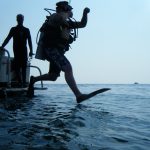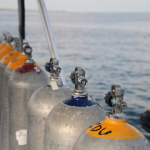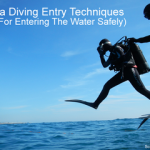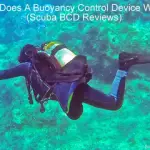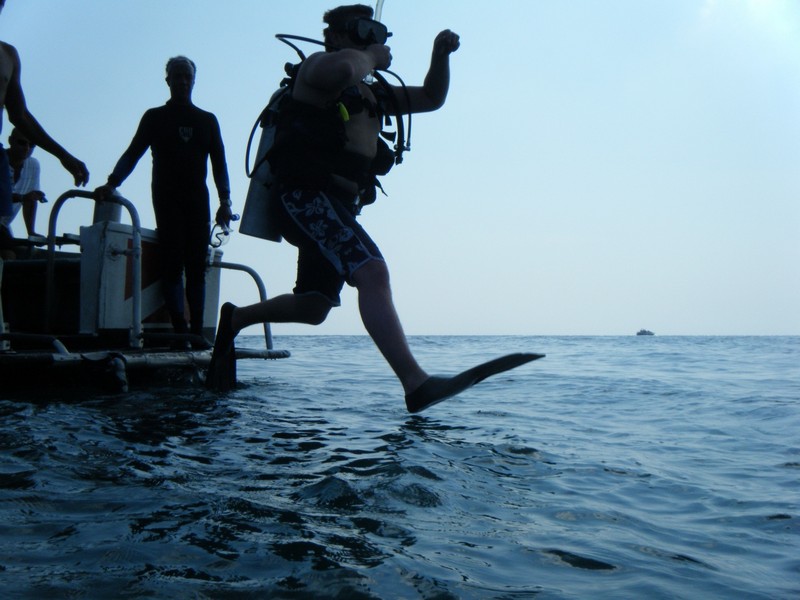
There may be times when you will need to do a negative entry when scuba diving, but not every one knows what this involves and why it may be necessary to enter the water negatively buoyant. Therefore, what is a negative entry in scuba diving, and why do dives sometime need it?
A scuba diving negative entry means you enter the water negatively buoyant, so you have no air in your BCD to allow a fast descent. Negative buoyant entries are often done as a backward roll from a RIB or Zodiac, but can be done using any entry technique including a stride entry from a hard boat.
“The best application I’ve used for a negative entry is when I’ve dived Elphinstone Reef in the Red Sea where a negative entry is a must in the strong currents, otherwise you miss the best dive spot on the dive, which is a plateau at 30m (99ft) watching sharks like hammerheads and thresher sharks.“
What is a negative decent?
A negative descent means you enter the water without air in your buoyancy control device (BCD), which means that after entering the water you will not pop back to the surface before your descent, and your your descent starts immediately.
Negative descents are not normally a problem for most experienced divers, but for novices or those with ear-equalising issues, this can be a challenge
What Are The Challenges With A Negative Dive Entry?
- Equalising your ears: If you have problems equalising your ears when diving, you may struggle with a negative entry and a negative descent.
- Beginner and novice divers: If you are a beginner diver you will still be perfecting your buoyancy control, learning to equalise your ears regularly, and remembering to equalise your mask, so using a negative entry may be too much as a beginner diver. This is especially true if the dive is in strong currents, as you probably shouldn’t be diving in strong currents as a novice diver. Log more dives before you attempt a dive that requires a negative entry and a negative descent. One of the best ways to do this is to dive on a liveaboard.
- Nervous divers: If you are still nervous when you dive, a negative entry and a negative descent are probably not a good idea until you are a more relaxed diver. Although it’s never good to be a nervous diver, it is often the case that when people first start diving they can be a bit nervous, and the best way to overcome nerves when diving is to do more diving.
Reasons For Negative Entry Diving
- Diving in a strong current: If you are diving in a current, and the dive is about getting to a certain spot for the best dive enjoyment, for example a plateau to observe sharks at Elphinstone Reef, you need to enter negatively buoyant and use a negative descent to avoid being swept away from the dive spot in the current.
- Diving at tiger beach: When diving Tiger Beach there are usually plenty of reef sharks and lemon sharks on the surface swimming around the dive platform, which means it is better to use a negative entry when a space opens between the sharks.
If you would like to dive with tiger sharks at Tiger Beach in the Bahamas, you may like to consider diving on a Bahamas liveaboard, which can be viewed using the following window:
Ways To Do Negative Entry
- Backward roll entry: You can use the backward roll entry for negative entry dives, and backward-rolls work well when diving from RIBs and Zodiacs. A tip for using a backward roll entry is for you and your buddy to enter the water from the same side of the RIB or Zodiac at the same time.
- Giant stride entry: You can use a giant stride entry for negative entry dives, and stride entries work well when diving from hard boats or on a dive liveaboard. A tip for using a giant stride entry is for you and your buddy to enter the water from the dive platform at the same time.
Negative Entry Diving Tips
Before you attempt your first negative entry scuba diving, here are a few pro tips for you to follow:
- Buddy check: You should be doing buddy checks anyway, but with a negative entry buddy checks are even more important. For example, making sure your air is switched on, as you don’t want to sink like a stone with no air in your BCD and with no air at your regulator.
- Make sure you are properly weighted: You need enough weight to be negatively buoyant, with no air in your BCD, but never use excessive weight as this will affect your air consumption during the dive.
- Enter at the same time as your dive buddy: You want to ‘negative entry‘ at the same time, or as close to the same time as your dive buddy, so you descend together on the dive. If either of you are waiting underwater for your buddy this will defeat the object of a negative entry. Especially if the reason for using a negative entry is because of strong currents.
- Perfect your entry: Make sure you know which entry technique you will be using, and if for example you choose the giant stride entry, make sure you clear the dive platform and hold onto your mask and regulator.
- Look for your buddy: Immediately when the bubbles around you clear, look for your dive buddy and descend together.
- Equalise your ears early and often: It is even more important you equalise your ears as early as possible, and as often as possible, as your descent will be faster than a normal dive entry.
- Equalise your mask: Remember to equalise the air in your mask to avoid mask squeeze and to equalise the pressure of the airspace inside your mask. This will prevent you getting red eyes and facial skin bruising.
- Descend head first and fin: It’s quicker and better to descend head-first, and to fin your descent when using a negative entry, especially in a current. If there is a strong current and you don’t use a negative entry, and if you don’t fin head-first, you will miss the spot you want to reach to enjoy the dive (see below about negative entry diving Elphinstone Reef).
- Control your descent: Even though you are using a negative entry to reach your dive depth as quickly as you can, you still need to control your descent by adding air to your BCD as you descend.
- Check on your buddy: Make sure to check in with your buddy regularly on your descent
When I dive the Red Sea on Elphinstone Reef, I always enter the water using a negative entry with a backward-roll entry from the liveaboard Zodiac.
The negative entry is used on Elphinstone Reef in order to descend to the plateau at around 30 metres (99 feet), as the current is strong at Elphinstone Reef, and if you don’t use a negative entry dive, and if you don’t fin to the plateau, the current will push you away and you’ll miss all the shark action.
But also be careful on Elphinstone Reef, as the current can also be a strong down-current that can take you to depths you would choose not to go. One time my buddy and me ended up at 65 metres (213 feet) deep on Elphinstone, and other buddy pairs were pushed even deeper, which was due to the strong down current.
You can read more about my experience, and how to deal with a down current here: How To Deal With A Down Current And Not Panic.
If you’ve never dived the Red Sea, or never dived Elphinstone Reef, I highly recommend it diving on a Red Sea liveaboard. With that in mind, take a look at the following window for Red Sea liveaboards to the Red Sea:
I hope you enjoyed this article about what is a negative entry in diving
I’d love to hear from you. Tell us about your adventures of diving and snorkeling, in the comments below. Please also share your photos. Either from your underwater cameras or videos from your waterproof Gopro’s!
If this article hasn’t answered all of your questions. If you have more questions either about snorkeling or scuba diving (or specifically about what is a negative entry in diving), please comment below with your questions.
There will also be many more articles about scuba diving (and snorkeling) for you to read and learn about these fabulous sports.
Have fun and be safe!

